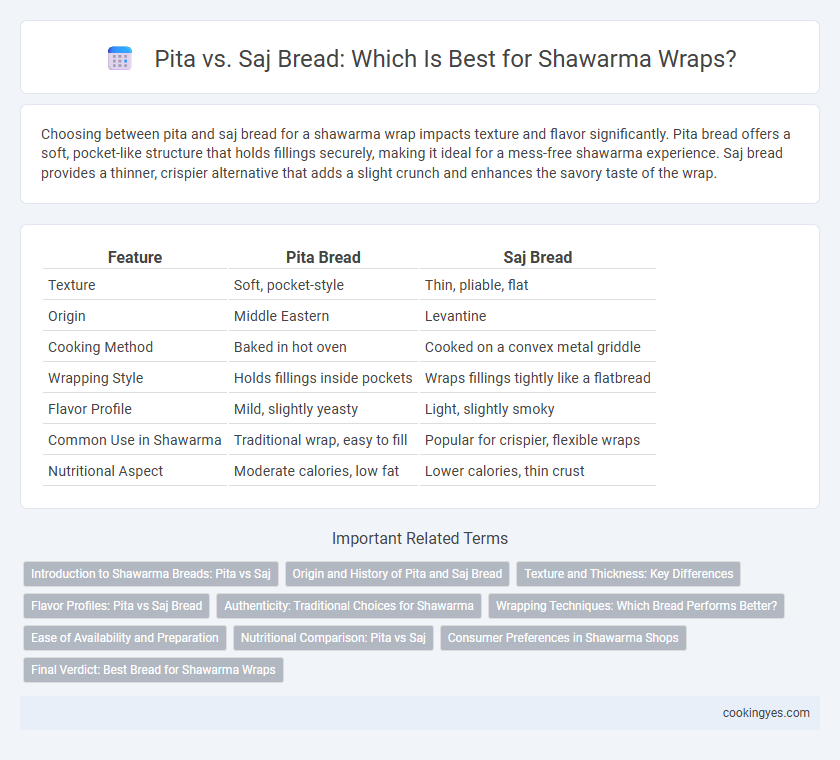Choosing between pita and saj bread for a shawarma wrap impacts texture and flavor significantly. Pita bread offers a soft, pocket-like structure that holds fillings securely, making it ideal for a mess-free shawarma experience. Saj bread provides a thinner, crispier alternative that adds a slight crunch and enhances the savory taste of the wrap.
Table of Comparison
| Feature | Pita Bread | Saj Bread |
|---|---|---|
| Texture | Soft, pocket-style | Thin, pliable, flat |
| Origin | Middle Eastern | Levantine |
| Cooking Method | Baked in hot oven | Cooked on a convex metal griddle |
| Wrapping Style | Holds fillings inside pockets | Wraps fillings tightly like a flatbread |
| Flavor Profile | Mild, slightly yeasty | Light, slightly smoky |
| Common Use in Shawarma | Traditional wrap, easy to fill | Popular for crispier, flexible wraps |
| Nutritional Aspect | Moderate calories, low fat | Lower calories, thin crust |
Introduction to Shawarma Breads: Pita vs Saj
Pita and Saj breads serve as the foundational wraps for authentic shawarma, each offering distinctive textures and cooking methods that influence flavor and experience. Pita bread, known for its soft, pocketed structure, is traditionally baked, making it ideal for holding fillings tightly without tearing. Saj bread, thinner and cooked on a convex griddle, provides a flexible yet crisp alternative that enhances the shawarma's taste with its slightly charred, smoky notes.
Origin and History of Pita and Saj Bread
Pita bread, originating from the Middle East around 4,000 years ago, is traditionally baked at high temperatures, causing its characteristic pocket to form, ideal for stuffing with shawarma fillings. Saj bread, with roots in Levantine cuisine, is a thin, round flatbread cooked on a convex metal griddle called a saj, dating back to ancient nomadic Bedouin tribes. Both breads showcase regional baking techniques that have shaped the shawarma wrap's texture and flavor, reflecting centuries of culinary evolution across the Mediterranean and Arabian Peninsula.
Texture and Thickness: Key Differences
Pita bread features a thicker, pocketed structure that holds shawarma fillings securely, providing a soft yet sturdy texture that complements juicy meats and fresh vegetables. Saj bread, thinner and flatter with a more flexible and crispy texture, offers a delicate wrap that emphasizes the flavors without overpowering the fillings. The choice between pita and saj bread impacts the overall eating experience, with pita delivering a hearty bite and saj creating a lighter, crispier shawarma wrap.
Flavor Profiles: Pita vs Saj Bread
Pita bread offers a soft, slightly chewy texture with a mild, yeasty flavor that complements the rich, spiced shawarma filling without overpowering it. Saj bread delivers a thinner, crispier bite with subtle smoky notes from the griddle, enhancing the savory taste and adding a contrasting crunch to the wrap. Both breads provide unique flavor profiles that influence the overall shawarma experience, with pita emphasizing softness and pillowy warmth, while saj highlights lightness and crisp texture.
Authenticity: Traditional Choices for Shawarma
Pita bread is the authentic choice for traditional Shawarma, characterized by its pocketed texture that holds meats, vegetables, and sauces securely, preserving the classic Levantine experience. Saj bread, a thin, flat, and pliable type of bread, offers a slightly different texture and is more commonly used in regional variations but lacks the signature pocket that defines a traditional Shawarma wrap. Opting for pita ensures an authentic wrap that honors the Shawarma's rich culinary heritage and delivers the iconic taste and structure expected in genuine Middle Eastern cuisine.
Wrapping Techniques: Which Bread Performs Better?
Pita bread offers a pocket that securely holds shawarma fillings, making it ideal for neat, compact wraps that prevent spillage. Saj bread, being thinner and more flexible, allows for tight rolling and a fold-over technique that enhances grip and ensures even distribution of ingredients. In terms of wrapping techniques, saj bread performs better for creating a snug, versatile shawarma wrap, while pita excels in providing a sturdy enclosure suitable for handheld consumption.
Ease of Availability and Preparation
Pita bread is widely available in supermarkets and requires minimal preparation, making it a convenient choice for shawarma wraps. Saj bread, while less common, often demands a specialized domed griddle for authentic cooking, which can limit its ease of preparation at home. The widespread accessibility of pita combined with its ready-to-use nature gives it an advantage in both availability and simplicity when crafting shawarma wraps.
Nutritional Comparison: Pita vs Saj
Pita bread typically contains around 165 calories per 60-gram serving with 33 grams of carbohydrates, 6 grams of protein, and 1.5 grams of fat, along with moderate fiber content. Saj bread has a slightly lower calorie count, approximately 150 calories per similar serving, with higher fiber and lower fat, making it a lighter option for shawarma wraps. Nutritionally, saj bread offers better digestive benefits due to its increased fiber and lower calorie density compared to pita, appealing to health-conscious consumers.
Consumer Preferences in Shawarma Shops
Consumer preferences in shawarma shops often favor pita bread for its soft texture and ability to hold fillings securely without tearing, enhancing the overall eating experience. Saj bread appeals to those seeking a thinner, slightly crisp wrap that offers a more delicate balance between crunch and chewiness, ideal for lighter shawarma variants. The choice between pita and saj bread frequently depends on regional tastes, with pita dominating in Western countries and saj preferred in Middle Eastern locales, reflecting cultural flavor profiles and dining habits.
Final Verdict: Best Bread for Shawarma Wraps
Pita bread offers a soft, pocket-like texture that holds shawarma fillings securely, making it ideal for a classic wrap. Saj bread's thin, flexible nature creates a lighter, crispier wrap, preferred for a more delicate bite and enhanced flavor absorption. For the best shawarma wrap, pita bread is often favored due to its sturdiness and ability to contain juicy fillings without tearing.
Pita vs Saj Bread for Shawarma Wrap Infographic

 cookingyes.com
cookingyes.com